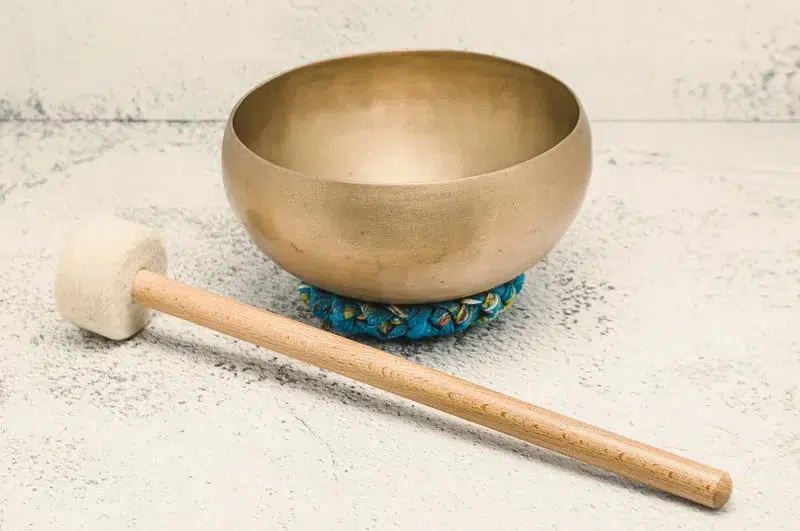If you’re in the market for a singing bowl, it’s important to be able to identify fakes. Unfortunately, there are many replicas and imitations out there that look similar to authentic singing bowls.
Not only do these fake singing bowls lack the quality of sound and experience that genuine ones offer, but purchasing them may also have negative financial implications and contribute to the exploitation of authentic artisans.

Key Takeaways:
- There are many types of sound bowls in the market
- Knowing how to identify original singing bowls can help you avoid disappointment and potential financial loss
- Authentic singing bowls offer a unique sound experience
- Purchasing authentic singing bowls supports the craftsmanship of genuine artisans
Content
Types of Fake Singing Bowls
There are different types of singing bowls, and it’s crucial to be able to identify them to avoid being scammed. In this section, I will outline the most commonly found types on the market
Bronze-coated steel bowls
These are the most widespread types of fakes available. They are made of steel and then coated with a thin layer of bronze.
They are usually sold at lower prices than genuine bronze bowls and can be easily recognized by their bright, shiny appearance and inability to produce rich, resonant sounds.
Machine-made bowls
Machine-made bowls are mass-produced using machines and can easily break, and they lack the unique features present in handmade bowls.
They are produced quickly and cheaply and lack the personal touch of artisan work. They usually lack the richness and depth of sound that is characteristic of authentic singing bowls.
Imitation antique bowls
Many replicas are labeled as “antique,” when in reality, they are not. These bowls are typically made from low-quality materials, and their designs are not authentic.
They are often sold at high prices, but they do not provide the same quality sound or feel as a genuine antique singing bowl.
It’s important to keep in mind that many manufactured singing bowls are designed to deceive consumers, and they can come in a wide range of materials and designs.
It’s essential to look out for these types of bowls and to use the key identification techniques outlined in the next section to confirm the authenticity of your singing bowl.
How to Identify Fake Singing Bowls
It can be challenging to distinguish between authentic and replica singing bowls, particularly for those unfamiliar with their characteristics.
Here are some steps you can take to identify them:
- Look for visual cues: Inspect the bowl’s design, color, and texture. Authentic singing bowls are often uneven in shape and have unique engravings that indicate their origin and maker. Counterfeit singing bowls are often machine-made and lack the irregularities that come with handmade bowls.
- Listen for auditory cues: Strike the bowl and listen carefully to the sound it produces. Authentic singing bowls have a clear, bright, and sustained sound that fades slowly. On the other hand, unoriginal produce a dull and short-lived sound.
- Test the resonance: Place the bowl on a flat surface and strike it gently. An authentic singing bowl should create a prolonged humming sound that you can feel in your body. Fake bowls often produce a weak and short-lived vibration.
- Check the weight: Singing bowls are typically made of bronze and are relatively heavy.
- Research the seller: If you’re buying online, do your research on the seller before making a purchase. Look for reviews, ratings, and comments from previous customers to gauge their credibility.
By following these steps, you can increase your chances of identifying the real one and avoid purchasing an imitation by accident.
Consequences of Purchasing Fake Singing Bowls

If you’ve purchased a fake singing bowl, you may have noticed that it doesn’t produce the same quality of sound as an authentic bowl. In fact, many fake bowls sound dull, and flat, and lack the resonance that is characteristic of authentic bowls.
This is because they are typically made from cheaper materials and do not undergo the same crafting process as authentic bowls.
Not only does a fake bowl provide an unsatisfactory experience, but it can also have financial implications and maybe even health problems using the wrong sound bowl.
You may have paid a higher price for a bowl you believed to be authentic, only to later discover it is fake. Authentic singing bowls can be pricey due to the time and effort it takes to create them, so it’s important to know what you’re paying for.
By purchasing fake bowls, you are also contributing to the exploitation of traditional artisans. These skilled craftsmen and women rely on the sale of authentic bowls to support their livelihoods.
When people purchase copies, they are taking away business from these artisans and not valuing their hard work and skill.
Supporting authentic artisans means preserving the ancient art form of singing bowl-making and sustaining the culture surrounding it.
It’s important to be able to identify a real singing bowl to ensure that you’re getting what you pay for and supporting the art form and its authentic artisans.
Conclusion
Identifying fake singing bowls is crucial for preserving the integrity of this ancient art form. By staying vigilant and knowing what to look for, you can avoid purchasing imitations and replicas that can negatively impact your experience.
Remember to pay attention to the sound quality, weight, and craftsmanship of a singing bowl before making a purchase.
It’s also important to support authentic artisans and their craft by purchasing from trustworthy sources. By doing so, you not only ensure the purity of your experience but also help keep this art alive for generations to come.
Now that you’re equipped with the knowledge to spot a real bowl, we encourage you to share this information with others to protect the authenticity of this beautiful art form.
FAQs
Here are the common questions that can help you get the real bowl instead of a replica:
Why is it important to be able to identify fake singing bowls?
It is important as it ensures that you are purchasing an authentic and high-quality product. They may not produce the same sound quality and may not provide the same experience as genuine singing bowls. Additionally, supporting authentic artisans and their craftsmanship helps to preserve the integrity of this ancient art form.
How to identify the real singing bowl?
Authentic singing bowls are usually made of high-quality metals and exhibit a certain level of craftsmanship.
Also, listen to the sound produced by the bowl. Genuine singing bowls have a unique and resonant sound, while fake bowls often produce a dull or metallic sound.
